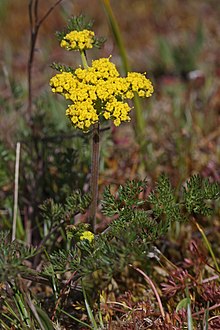Lomatium

Lomatium is a genus of about 75 species[1] of perennial herbs native to western North America; its common names include biscuitroot, Indian parsley, and desert parsley.[2] It is in the family Apiaceae and therefore related to many familiar edible species such as carrots and celery; some Lomatium species were extensively used by Native Americans in the inland Northwest as a staple food.
Roots range from woody taproots to more fleshy underground tuberous-thickened roots. Most lomatiums are desert species or grow on bluffs where water is limited for most of the year. They are green and grow the most during the spring when water is available, then set seed and dry out completely above ground before the hottest part of the year, while storing the energy they gained from photosynthesizing while water was available to them in their deep roots. For most of the year, the plant is not visible; the brown tops often are blown off or easily crushed, but it lies dormant underground for the next spring.
The flowers are arranged in compound umbels, without involucral bracts (or with inconspicuous bracts). The flowers are white or yellow, more rarely a purple or maroon color. As with most Apiaceae, the fruit sets the genus apart from other yellow- or white-flowered look-alikes such as Cymopterus and Orogenia. Uniquely, they are dorsally flattened and winged, which can be papery or corky, but help the seed to disperse further on the wind. The dorsal ribs may or may not be on the fruit, but are narrowly winged if at all.[2] Leaves are mainly basal and dissected (ternately, pinnately, or ternate-pinnately dissected or compound), many look like ferns or can be mistaken for them.
